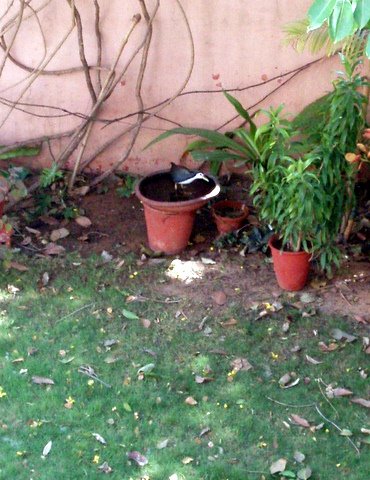Urban Wildlife
-Arun Dube
Birds require food, water and an adequate number of nesting places for them to remain in a particular garden.
Much to the consternation of my gardener, I have given him strict instructions that bushes and trees in the garden are not to be pruned so that birds can safely build their nests in them.
I place a large earthen bowl of millet on the terrace of my house and also two large bowls of water, one on the terrace and the other in the shade of a ‘jamun’ tree in the garden. I have been doing this for years and refill the bowls daily, sometimes even twice
a day. These bowls have drawn birds to the garden over the years and it is always a joy to watch them.
Regular, daily visitors to the garden are peafowl, partridges, doves, pigeons, sparrows, rose-ringed parakeets, plum-headed parakeets and mynahs. During the winter months, a large flock of rosy starlings takes up residence in the garden from October to early
March, before flying off. Hoopoes also come during winter to the garden. There are some small birds which are permanent residents. They are insect eaters and are mostly to be seen either on the lawn or in the creepers and hedge. The more unusual ones are the
Oriental Magpie Robin, which is a small, predominantly-black bird with white streaks, and the Ashy Prinia.
I am lucky to get interesting avian visitors like the Hornbill, Golden Oriole, Greater Coucal and the Flameback woodpecker regularly. Sometimes, I find Coppersmith Barbets and Spotted owls in residence in the old branches of the two jamun trees in the garden.
While the coppersmiths announce their arrival quite loudly, the owls are more discreet and make their presence known only at night.
One extremely unusual resident at present is a White-breasted waterhen, which has taken up residence in some bushes near a lotus-filled pond in the garden. At first I thought it had lost its way but it has been staying in the garden since February this year
so I suppose it finds the garden to its liking. It is extremely wary of people so I have to watch it from a distance. It generally feeds on tadpoles and small water insects in the pond. It is not injured and sometimes flies from the lawn to the tops of trees
in the evenings.
This I consider an appreciation of a true garden.

(Arun Dube is a resident of Jaipur and can be contacted at dubearun@gmail.com)
|